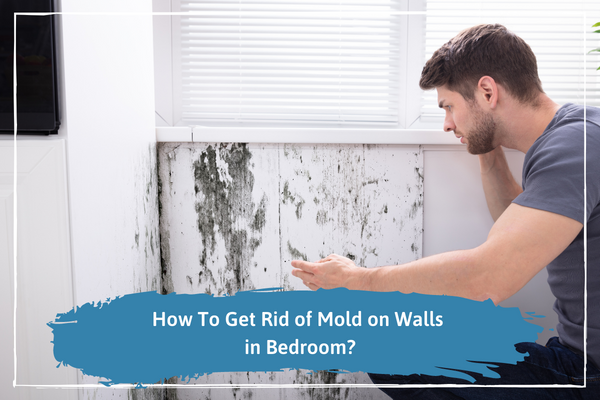Mold on Walls in Bedroom?Are you dealing with a problem of mold on the walls in your bedroom? If so, you’re not alone. Mold is a common problem in many homes, especially in humid and damp environments. Mold can cause significant health risks, so it’s important to understand how to identify and get rid of it. In this comprehensive guide, we’ll cover everything you need to know about mold in bedrooms, including the dangers, how to inspect for and get rid of it, and when to call in a professional.
What is Mold?
Mold is a type of fungus that can grow indoors or outdoors. It’s usually found in damp and humid environments, such as bathrooms or basements. Mold can cause a variety of health problems, such as respiratory issues, skin irritation, and even allergic reactions. It’s important to identify and get rid of mold as soon as possible to avoid any potential health risks.

Mold usually appears as green, black, or white spots on surfaces. It can also be fuzzy or slimy in texture. Mold can grow on any surface, including wood, fabrics, and walls. In bedrooms, it’s most commonly found on walls, ceilings, and windows.
Causes of Mold in Bedrooms
Mold can thrive in any humid environment, but it is most common in bedrooms. Bedrooms tend to be more humid than other rooms due to the presence of people and their activities. People also tend to keep their windows closed, which can trap in moisture and create the perfect environment for mold to grow.
Common causes of mold in bedrooms include:
- Poor ventilation. Without proper ventilation, moisture can accumulate and create an ideal environment for mold to grow.
- Leaky pipes or roofs. If there’s a leak in the bedroom, it can create a damp environment that’s perfect for mold growth.
- Moisture from showers and baths. If you take a hot shower or bath, the steam can travel through your bedroom and create a humid environment.
- Dirty air ducts. If your air ducts are dirty and clogged, it can cause moisture to accumulate and create the perfect environment for mold to grow.
Signs of Mold in Bedrooms
It’s important to identify the signs of mold in your bedroom as soon as possible. If you notice any of the following signs, you may have a mold problem:
- Musty smell. Mold has a distinctive musty smell, so if you notice a strange smell in your bedroom, it could be a sign of mold.
- Discolored walls. If you notice discolored patches on your walls, it could be a sign of mold.
- Stains or streaks on walls or ceilings. If you notice any stains or streaks on your walls or ceilings, it could be a sign of mold.
- Water stains. If you notice any water stains on your walls, it could also be a sign of mold.
Dangers of Mold in Bedrooms
Mold can be a serious health hazard in any area of the home, but it is particularly dangerous in bedrooms. Bedrooms are often considered to be the most important rooms in the house, and they are where many people spend the majority of their time. This means that mold growth in these rooms is especially concerning.
Mold can cause a wide variety of health problems, including asthma, allergies, and even chronic lung disease. It can also cause serious damage to your lungs if you are exposed to it frequently enough. In addition, mold can release toxic compounds into the air which can be harmful to your health.
If you suspect that there is mold growing in your bedroom, it is important to take action immediately. You should remove all of the affected materials from the room and seal them off using plastic wrap or duct tape. You should also ensure that the room is properly ventilated so that the toxic compounds released by the mold cannot reach you. If you experience any breathing difficulties after being exposed to mold, please seek medical attention as soon as possible.
How to Inspect for Mold in Bedrooms?
If you suspect that there may be mold in your bedroom, it’s important to do an inspection. Here are some tips for how to perform a thorough inspection:
Look closely at walls and ceilings. Look for discolored patches or streaks that could indicate mold growth.
Check around windows and doors. Check for water stains which could be a sign of mold.
Look for any signs of moisture such as condensation on windows or walls.
Check for musty odors. If you smell anything strange, it could indicate the presence of mold.
Use a flashlight to look in corners and other dark places where mold might hide.
If possible, use a thermal imaging camera to detect any hidden mold.
Take samples of the air and send them to a laboratory for testing. This can help determine if there is mold in your bedroom and identify which type it is.
If you find any evidence of mold in your bedroom, it’s important to take action immediately. Contact a professional to assess the situation and determine the best course of action. They can help you properly remove the mold and prevent it from returning in the future.
Take steps to prevent mold. To help stop mold growth in your bedroom, make sure that you keep the room well-ventilated, fix any leaks or other sources of moisture right away, and clean regularly. It’s also important to inspect your air ducts on a regular basis. If your air ducts are dirty and clogged, it can cause moisture to accumulate and create the perfect environment for mold to grow.
How to Get Rid of Mold on Walls in Bedrooms?
If you find mold in your bedroom, it’s important to take action as soon as possible. The best way to get rid of mold on walls in your bedroom is to use a mold removal product. There are many different types of mold removal products available, so it’s important to choose one that’s specifically designed for use on walls.
Before using a mold removal product, it’s important to clean the affected area. Start by vacuuming the area with a HEPA filter to remove any visible mold spores. Then, use a damp cloth to wipe down the walls. Make sure the cloth is damp, not wet, as this will help to remove any remaining mold spores.
Once the area is clean, you can apply a mold removal product. These products are designed to kill mold spores, so it’s important to follow the instructions carefully. Make sure to wear protective clothing, such as gloves and a face mask, when applying the product.
After you’ve applied the mold removal product, it’s important to take steps to prevent mold from returning in the future. Make sure that your bedroom is well-ventilated and keep windows and doors sealed when not in use. It’s also a good idea to inspect your air ducts on a regular basis to make sure they are clean and free of debris. If your air ducts are dirty and clogged, it can cause moisture to accumulate and create the perfect environment for mold growth.
Cleaning Products to Use for Mold Removal
There are a variety of cleaning products available for mold removal. Here are a few of the most popular products:
- Bleach: Bleach is an effective mold remover, but it can be toxic if not used properly. Make sure to wear gloves and protective clothing when using bleach.
- Vinegar: Vinegar is a natural mold remover, and it’s safer to use than bleach.
- Baking soda: Baking soda is another natural mold remover. It’s safe to use and it’s effective at killing mold spores.
- Hydrogen peroxide: Hydrogen peroxide is an effective mold remover and it’s safe to use.
DIY Mold Removal Techniques
If you don’t want to use a commercial product to remove the mold in your bedroom, there are a few DIY techniques you can try. Here are a few of the most popular DIY mold removal techniques:
- Use a dehumidifier: A dehumidifier can help to reduce the humidity in your bedroom, which can help to prevent mold from growing.
- Increase ventilation: Increasing ventilation in your bedroom can help to reduce the humidity and prevent mold from growing.
- Use essential oils: Certain essential oils, such as tea tree oil and eucalyptus oil, can help to kill mold spores.
- Clean regularly: Regular cleaning can help to prevent mold from growing in your bedroom. Make sure to clean all surfaces, including walls, floors, and windows.
When to Call a Professional to Remove Mold?
If you’ve tried a few DIY techniques and the mold is still present, it’s time to call a professional. A professional mold removal company can identify the source of the mold and recommend the best course of action for removal. They can also provide advice on how to prevent mold from growing in the future.
It’s important to get the mold removed as soon as possible, as it can cause a variety of health problems if not treated quickly. If you suspect that there is mold in your bedroom, don’t hesitate to call a professional for help.
FAQs
Q: What is the best way to get rid of mold on walls?
A: The best way to get rid of mold on walls is to use a mold removal product specifically designed for this purpose. Make sure to follow the instructions carefully and wear protective clothing when applying the product.
Q: Are there any DIY methods for removing mold?
A: Yes, there are a few DIY methods for removing mold. Some of these methods include using a dehumidifier, increasing ventilation, and using essential oils.
Q: Is it safe to use bleach to remove mold?
A: While bleach can be an effective mold remover, it can also be toxic if not used properly. It’s best to wear protective clothing and gloves when using bleach for mold removal.
Q: When should I call a professional to remove mold?
A: If you’ve tried a few DIY methods and the mold is still present, it’s time to call a professional. A professional mold removal company can identify the source of the mold and recommend the best course of action for removal. They can also provide advice on how to prevent mold from growing in the future.
Conclusion
Mold can be a serious problem in bedrooms, so it’s important to understand how to identify and get rid of it. In this comprehensive guide, we’ve covered everything you need to know about mold in bedrooms, including the dangers, how to inspect for and get rid of it, and when to call in a professional. If you’re dealing with a problem of mold on walls in your bedroom, it’s important to take action as soon as possible to avoid any potential health risks.





GIPHY App Key not set. Please check settings